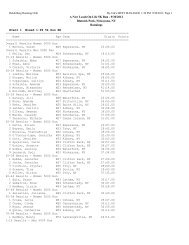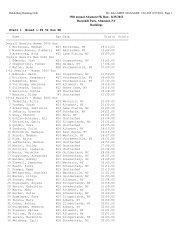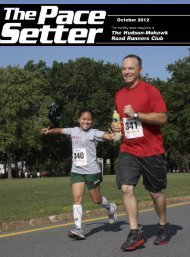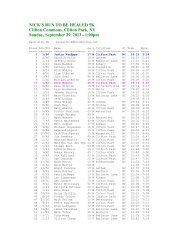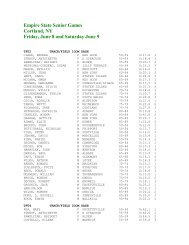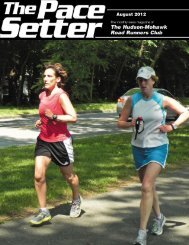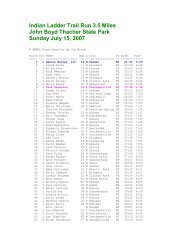The Pace Setter August 2009 - Hudson Mohawk Road Runners Club
The Pace Setter August 2009 - Hudson Mohawk Road Runners Club
The Pace Setter August 2009 - Hudson Mohawk Road Runners Club
- No tags were found...
Create successful ePaper yourself
Turn your PDF publications into a flip-book with our unique Google optimized e-Paper software.
<strong>The</strong> Running Doctorby Dr. Tim MaggsFlexible vs. Rigid OrthoticsI just returned from 3 days at the VermontCity Marathon. I talked with so many runners,and was, once again, reminded of the confusionthat exists out there regarding custom orthotics.All runners work hard to avoid injuries,yet there are still so many injured runners. Ithink the only thing greater than the number ofinjured runners is the number of opinions as tohow to prevent injuries.As I tell my kids, "I'm right." So, should youcontinue reading this article, at the very least,you'll see I have very polarized opinions. Atleast these opinions are based on 30 years ofworking with patients. Truth is, I tell my patientsto only listen to the person they are paying. Ifthey don't like what he/she is saying, pay/listento someone else. But, opinions are plentiful,and most are worth what you pay for them. (Exceptthis opinion, of course).I'm a believer that most of us would do wellto consider custom orthotics. Virtually everyonehas some degree of imbalance betweentheir right and left foot, and most of us currentlyhave arches that are either too high, or to somedegree have fallen. For those few who haveperfect arches, most likely time and gravity willcause them to fall from the graces of normal (soyou, too, would benefit from orthotics).When arches of the feet are less than perfect,the dilemma isn't in the feet, it's in thestructures above; the knees, hips, low back, etc.<strong>The</strong>se regions are dependent on the feet for balance.Foot imbalance is the beginning of joint!tendon/muscle breakdown and leads to mostof the injuries runners face today. With customorthotics, we remove many imbalances, startingwith the symmetry between the right andleft foot. As I tell my runner patients, "It doesn'tmatter how ugly and imbalanced your feet are,custom orthotics fix them.""Do I have to wear them forever?", is a commonquestion. Of course you do, if your goal isto delay breakdown and minimize injuries. And,you must wear them in most of your shoes duringthe day, not just in your running shoes. <strong>The</strong>greatest benefit of wearing custom orthotics isthat the centers of gravity in all joints improve,reducing global wear and tear over time.Rigid orthotics restrict normal mobility inthe foot, which opposes nature's goal. Mobility(motion) is mandatory in keeping joints healthy.In addition, if our foot mobility is restricted,especially during running, muscles, tendonsand joints above are being subjected to an increasedworkload that will lead to additionalstress-based injuries.We see many younger athletes with injurieslike shin splints, ilio-tibial band syndrome, calf,achilles and knee problems. Again, the restrictionand discomfort of rigid orthotics makesresolution of these injuries more difficult.<strong>The</strong> Foot has 3 Arches<strong>The</strong> final consideration when purchasingcustom orthotics is the need to address all 3arches of the foot. <strong>The</strong>re is the well known medialarch, the transverse arch, under the metatarsalarea, and the lateral arch, under the outerborder of the foot. <strong>The</strong>se 3 arches provide asuspension-like bridge support to the foot, 'puttingthe foot into the strongest position possible,and creating a symmetry between right andleft. This increases the balance and support forall tissues above. With flexibility and shock absorbingmaterials, this orthotic can help runnersavoid injuries and run for many more miles.Case HistoryPictured in Figure 1 is a weight bearing scanof a young runner with severe supination (higharches). A supinated foot is a rigid and sensitivefoot that is mostly weight bearing on the outsideof the foot. This foot type needs additionalcushioning and shock absorption to reduce theamount of shock that is transferred up the bodywith each and every step. In addition, this foottype would have a heel wedge encouraging thefoot to become more pronated.Flexible vs. RigidNow, with that background, which shouldwe consider when purchasing orthotics? Firstof all, there are 3 basic foot types: pronator(flat feet), neutral (normal medial arches) andsupinator (high arches). My experience, afterdealing with many runners, is that an inordinateproportion of runners have high (medial)arches. <strong>The</strong>se are rigid, sensitive feet that donot provide shock absorption for the individual,especially when running. To use a rigid orthoticwould only add to the shock going up thebody, therefore, a flexible orthotic with shockabsorbing materials would seem to make moresense. And, be a lot more comfortable.Figure 1With a little forethought, injury preventioncan be relatively easy. Good luck, and have agreat month.Dr. Maggs can be heard on his live internet radioshow, <strong>The</strong> Structural Management






